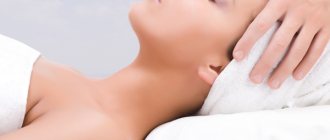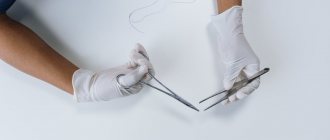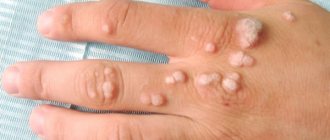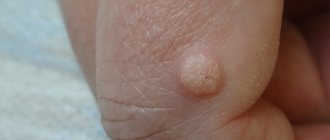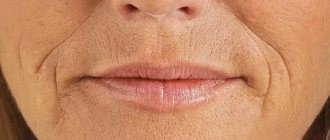Once your general condition has stabilized and you have been discharged from the hospital, you can process the stitches yourself. How to independently treat stitches after surgery at home?
The first stage of treatment is removal of the bandage. If this is difficult, then wet it generously with hydrogen peroxide, then remove it and assess the condition of the wound - whether there is blood or swelling.
The main stage, which requires careful adherence to the rules of asepsis and antiseptics, is processing.
Using a sterile bandage, properly treat the skin in the direction from the wound, at a distance of at least 2.5 cm, and only then apply a sterile bandage.
You can use a bandage to secure it; it will prevent slipping and will hold the bandage securely. Stitches should be disinfected at home every day, at the same time.
Important! Wash sutures only with solutions prescribed by a doctor: hydrogen peroxide, Miramistin solution.
Possible reasons for a wet seam
If you observe the postoperative wound, for the first few days it will be a little damp and even hot. The first few hours the suture may bleed. Then the blood coagulates and dries, but shiny droplets are still visible on the wound - transudate. This is a natural transparent moisture secreted by the serous membranes as a result of fluid filtration by blood vessels.
Over time, the serous fluid no longer flows so abundantly, because the condition of the tissue returns to normal. Otherwise, the amount of transudate may increase. This indicates the beginning of an inflammatory process, the causes of which are different.
- Incorrectly installed or removed drainage system too early.
- Low quality suture and dressing materials.
- Dressing under non-sterile conditions.
- The intervals between dressings are too long.
- Incorrectly chosen treatment tactics with antibiotics and local remedies.
- Reduced immunity of the patient.
The abundant secretion of serous fluid is a kind of protective reaction of tissues to the inflammatory reaction. But it turns out that the situation is only getting worse: a humid environment leads to the fact that the suture festers after the operation, i.e. inflammation develops more rapidly. Transudate is transformed into exudate - a liquid of inflammatory nature.
In addition to serous fluid, transparent or whitish ichor may ooze from the postoperative suture - this is lymph that is released from small capillaries. With the ichor flowing out of the wound, toxins and microbes are “washed out”, so this process is natural for the first few days. If it does not stop, then bloody discharge can also cause the wound to get wet and not heal for a long time.
What to do if the seam comes apart?
Sutures after surgery come apart quite rarely, this is largely due to the severe current illness, but there are other reasons:
- If the reason for the operation was purulent diseases - purulent cholecystitis, peritonitis.
- Incorrect management of the postoperative period - early physical activity, injury to the postoperative suture.
- The stitches are too tight.
- Low muscle tone, excess weight, tumors.
If internal organs and subcutaneous fatty tissue are visible at the site of the broken suture, then immediate hospitalization is indicated.
If the edges of the wound are partially separated, and when pressure is applied, serous fluid or pus oozes from it, then you can turn to the surgeon who performed the operation for help.
Important! If the edge of the wound has split open, you should never disinfect the damage yourself! When alcohol, iodine solution or brilliant green gets into the wound cavity, tissue necrosis develops, which complicates treatment and can lead to sepsis.
Further treatment tactics will be based on the results of blood tests, bacteriological culture of the wound contents, and diagnosis using ultrasound or CT will provide information about the condition of the internal organs.
Treatment of postoperative sutures
In most cases, the patient spends the first 7-10 days after surgery in the hospital, where his wound is regularly bandaged under the supervision of the attending physician. And if any problems are discovered, measures are taken immediately. The patient is discharged with the stitches removed and only the wound in normal condition. But literally the next day after discharge, the suture may begin to get wet and then fester.
The goals of treating a weeping suture after surgery are as follows: it is necessary to relieve inflammation by destroying pathogenic microflora, and also to dry the wound to avoid recurrence of suppuration. What to do, what measures to take, and what means to use?
Attention! If the suture gets wet and suppurates, you should go to the hospital! Self-medication is an extreme measure that you can resort to if you are unable to see a doctor.
Local remedies
External preparations will help cope with wetting and inflammation of the seam. In the case of a weeping wound, you need to use gels. They, unlike ointments and creams, do not leave a greasy film and allow the skin to breathe, which is very important for drying the wound. Solcoseryl is one of the most effective gels for postoperative wounds.
If the postoperative suture continues to get wet, you can also use powders. They also have a drying property because they absorb moisture while promoting healing. For example, Baneocin powder. It has a pronounced antimicrobial effect and is able to effectively heal weeping wounds.
The gel or powder should be applied to a clean wound, so it must be treated first. First, remove dead skin and dirt using hydrogen peroxide. Then blot the seam with a sterile napkin, drying it in this way, and only then apply the gel.
By the way! Wet wounds heal better in the open air. Therefore, the patient can apply bandages only at night or when leaving home.
There are cases when the suture bleeds for a long time after surgery. This also cannot be left like this, because bleeding indicates damaged blood vessels through which infection can enter the body. In this case, in addition to antibacterial and anti-inflammatory agents, you also need to use antiseptics. For example, brilliant green or Betadine (iodine solution). [flat_ab >
Medicines
When the seam simply gets wet, it cannot be treated with pills. Another thing is the development of inflammation. Antibiotics may be needed here. What kind of drug it will be, as well as its dosage and duration of administration will be determined by the doctor. Usually these are broad-spectrum antibacterial drugs.
If the suture does not heal after surgery
It is necessary to resort to surgery in case of accumulation of exudate inside the wound. The formation of an abscess is indicated not only by the wetting of the suture and the unpleasant odor from it, but also by an increase in the patient’s temperature.
The operation to evacuate purulent contents is performed under local anesthesia (injection). This is a shallow opening of the abscess, probing it and installing drainage. If the excision was extensive, additional sutures are applied. In some cases, a sterile bandage is sufficient. After such an intervention, the patient remains in the hospital for a couple of days. He is prescribed rest, antibiotics and physiotherapy.
Healing and removal of sutures, on what day?
It is almost impossible to make an accurate forecast and clearly formulate the healing time of postoperative sutures. How many days after sutures can be removed depends on many factors.
On average, it takes 8-9 days for an uncomplicated postoperative wound to heal. After which, thread removal is indicated if artificial material was used during stitching.
In different parts of the body, soft tissue regeneration occurs at different rates.
- During a caesarean section, the sutures can be removed on the 10th day.
- For amputation - on the 12th day.
- For operations on the abdomen and abdominal organs - on the 7-8th day.
- For operations on the chest organs - after 14-16 days.
- For facial surgeries – after 7 days.
If the incision site itches, this indicates normal healing by primary tension of the wound.
Normally, after the edges of the wound have fused, the threads are easy to remove, but if you ignore the timing of removal, inflammation and redness of the scar will begin.
It is advisable to wet the seam after healing , when the edges of the wound form into a scar. But until the stitches are removed, after water procedures, wipe the scar dry.
Often, when trying to remove stitches yourself, part of the thread remains in the wound. Upon examination, it is easy to see the place where the thread sticks out, going into the soft tissue.
The consequences of such self-medication are a fistula at the suture through which infection occurs. Pathogenic organisms freely enter the body cavity, a significant thickening of the scar is noticeable, and an unpleasant odor appears from the wound.
How to avoid getting the seam wet
Preventing the postoperative suture from getting wet is easier than treating a festering wound later. Therefore, patients must take proper care of their sutures. The rules of care are elementary and logical, but for some reason some people still neglect them.
- Change the bandage according to the regimen prescribed by the doctor. Minimum – once a day. If bandages quickly become wet and leak, you should increase the frequency of dressings.
- Changing the dressing should be done with clean hands and without unauthorized persons or animals in the room.
- All dressings (bandages, plasters, cotton wool) must be sterile.
- The seam should not be subjected to mechanical stress: friction against clothing, scratching, picking.
- Do not wet postoperative wounds until they are completely healed.
- If there is any suspicion of pathology (the wound is oozing, the suture has changed color, has festered, become inflamed), you should consult a doctor.
A suture that gets wet after surgery is not only an unpleasant problem that spoils bed linen and clothing, but also a risk of complications in the form of ulcers and necrosis. This also extends the healing time and quality of the suture, which as a result can turn into an unsightly colloidal scar. Therefore, you need to properly care for postoperative wounds and consult a doctor on time.
Patches and ointments for scar care
As you know, a postoperative scar tends to dry out, become rough and insensitive. Moreover, in some cases, the stitches on the knee can “stretch” and become more noticeable. Several means are used to combat these unpleasant phenomena.
These include:
- Omniplast patches
. Some doctors recommend using them for several months after surgery. Adhesive plasters fix the edges of the wound and prevent them from overstretching. This improves the appearance of the scar. - Mederma and Contractubex
. Ointments have fibrinolytic, anti-inflammatory and reparative effects. They promote scar resorption and make it less noticeable. You can start using these ointments 2-3 months after surgery. - Vaseline and natural vegetable oils
. Effective in combating roughening and drying of the skin. The use of these products helps make the scar soft, elastic and more sensitive. - Physiotherapeutic procedures.
To care for postoperative scars, phonophoresis with special absorbable solutions is most often used. With its help, you can quickly get rid of unpleasant symptoms.
Lymph and lymphatic system
Lymph is a clear, colorless liquid containing lymphocytes, the scientific medical name for ichor. It always begins to stand out at the site of any skin damage.
Having received a wound, a person most often treats it independently at home with an antiseptic (hydrogen peroxide or brilliant green), then covers it with a plaster or bandage. The main task in treatment is not to introduce infection into the healing wound. After all, even after it has been tightened by a crust, the risk of infection exists. If after a long time a wound, for example on a leg, does not heal, the person panics and goes to the doctor with the words: “Help, fluid is oozing from the leg.”
Any doctor will immediately reassure the patient, because lymph is designed by nature to remove salts, water, protein and toxins from tissues and return them to the blood. Lymph is always contained in the human body in a volume of 1-2 liters.
The lymphatic system is a very complex component of the vascular system of the human body. It is involved in metabolism. Its main function is to cleanse and disinfect the body of the “garbage” accumulated inside and prevent the penetration of external infections.
The lymphatic system is involved in maintaining and improving human immunity, protecting against viruses and harmful microbes.
Prevention of suppuration of sutures
With timely treatment, in 95% of cases it is possible to achieve rapid and complete cessation of the infection. It is important to promptly drain the wound and change the antibiotic. If the course is unfavorable, the consequences can be very serious. There is a possibility of developing gangrene or sepsis.
In addition, prevention of suppuration of a postoperative suture should include compliance with a number of aseptic and antiseptic rules. They consist of preparing the patient before surgery and caring for him after it. Preparing for surgery involves identifying infections in the body and getting rid of them. That is, cure all existing diseases and sanitize the oral cavity. After the operation, it is necessary to strictly monitor hygiene, properly carry out antiseptic treatment, and at the first symptoms of inflammation, take measures to eliminate it.
In order for the sutures to heal faster, follow all the rules, do not lift heavy objects to avoid the suture coming apart, do not remove the resulting crust, eat well and increase your immunity level. Only then will it be possible to significantly reduce the risk of complications. This is why it is so important to follow all recommendations.
Causes of lymph flow
- Injuries and wounds. The flow of lymph in these situations is absolutely normal. In this way, the body takes care of us and removes poisons and toxins that may have entered the body.
- Surgical intervention. The healing of the suture is accompanied by the flow of lymph. If the amount of leaking lymph is small and there is no suppuration, then you should not worry.
- Leakage of ichor or lymph from the navel is a common occurrence in newborn babies. This indicates a normal healing process in the umbilical area. Only in a situation where yellow liquid appears from the wound (it has festered), the baby’s parents, under the supervision of a doctor, treat with an ointment that contains antibiotics. Lubricate the wound with ointment several times a day, and use regular brilliant green for drying.
- In women after a cesarean section, healing of the suture also occurs with lymph discharge. Treatment methods are the same as when caring for the umbilical area in babies.
- In older people, prolonged discharge of ichor from a wound usually occurs after surgery. Lymph is released at the scar site.
- Trophic ulcers.
What is seroma?
If the seam hurts and a lump appears, then these are the first symptoms of seroma.
Seroma is a complication after surgery, manifested as a lump or swelling in the suture area.
It develops due to the fact that during the operation a large volume of tissue is dissected and fluid – lymph – is released around it.
If analgesics and anti-edema drugs are insufficiently introduced into the body, the fluid stagnates in the wound channel and it is painful for the patient to touch the tissues.
Leakage of lymph in trophic ulcers
One of the serious complications in which the situation of lymph leakage from wounds on the legs occurs is trophic ulcers. Ulcers appear with such a common disease as varicose veins.
Trophic ulcers are a chronic process, usually lasting more than 6 weeks, in which a skin defect occurs on the leg (usually on the lower leg) with a weak tendency to heal. This disease occurs due to venous stagnation of blood caused by varicose veins.
The most common cause of ulcers is increased stress on the veins of the legs when a person walks for a long time or spends time standing on his feet. If the patient engages in heavy physical labor and is not treated, the disease progresses. Thinning of the skin and walls of the veins in the legs occurs, the veins “come out” and become visible and painful.
When trophic ulcers appear, lymph and purulent-bloody discharge flow, and the smell is usually unpleasant. Itching appears when cleansing. In this situation, urgent effective treatment is necessary, the purpose of which is to clean the wound and prevent infection.
The result of treatment of trophic ulcers.
Suture healing mechanism
- Connective tissue with fibroblasts is formed. These are the cells that accelerate recovery and eliminate tissue defects.
- Epithelium forms on the wound, which prevents the penetration of pathogenic microorganisms.
- Tissue contraction: the wound contracts and closes.
Many factors influence the healing process:
- Age. At a young age, recovery is faster and much easier, and the likelihood of complications is less. This is due to the body’s immunity and its resources.
- Weight factor. The wound will heal much more slowly in overweight or thin people.
- Nutrition. Recovery will depend on the amount of substances supplied with food. After operations, a person needs proteins as building materials, vitamins and microelements.
- Water balance. Dehydration negatively affects kidney and heart function, slowing healing.
- Weak immunity can lead to complications: suppuration, various discharges, skin irritation and redness.
- Presence of chronic diseases. Diseases of an endocrine nature, blood vessels and tumors are especially affected.
- Function of the circulatory system.
- Restriction of oxygen access. Under its influence, recovery processes occur faster in the wound.
- Anti-inflammatory drugs slow down recovery.
How to stop lymph flow
In a situation where discharge from a small wound bothers the patient with unpleasant sensations, doctors recommend treatment with hydrogen peroxide (using a piece of bandage or a cotton swab). If the situation does not improve or suppuration occurs, then you should undergo a course of more complex drug treatment: ointments with antibiotics (for example, Levomikol) are most often prescribed.
If drug treatment for suppuration does not help, then the wound is often opened surgically, then the pus is removed and the wound is disinfected. Next, treatment is carried out until the wound surface is completely scarred.
What is strictly forbidden to eat
The list of prohibited products is quite lengthy. It includes all food products that can additionally burden the body, because the main forces should go into speedy healing of the sutures.
| Prohibited Products | |
| Bread | Rolls, bread, pies and any other baked goods |
| Dairy products | Milk, kefir, cheese, yogurt. You can’t even eat completely low-fat foods. |
| Vegetables | Tomatoes, cucumbers, zucchini, onions, dill, radishes, potatoes, corn, garlic, cabbage, lettuce, eggplant, basil, peas, asparagus, etc. |
| Sauces | Mayonnaise, tartar, remoulade, meuniere, salsa, pesto, bolognese, satsebeli, tkemali, horseradish, chili, adjika, tabasco, barbecue, chocolate, fruit, vanilla, caramel, ketchup, soy, guacamole, bechamel, thousand islands, etc. . |
| Beverages | Juices, cola, cocoa, coffee, alcohol and any other carbonated drinks |
| Sweet | Sugar, honey, cream, meringue, jam, jam, marmalade, jelly, marshmallows, sweets, toffee, caramel, lollipops, that is, any products with a large or minor addition of sugar |
| Semi-finished products | Frozen cutlets, dumplings, semi-finished fish products, etc. |
Additionally, the use of all types of seasonings that can cause stomach irritation is prohibited. Do not fry or eat smoked foods. Anything that must be heat treated can only be boiled or cooked in a steam bath. It is possible to bake or stew with a minimum amount of oil, or best without it at all.
Treatment with herbal decoctions and infusions
As an additional therapy for lymphorrhea, treatment with folk remedies is used:
- plantain infusion helps stabilize the flow of lymph. Freshly picked plantain leaves are crushed. Then in the evening the mixture is poured with water at a ratio of 2:500. In the morning, drink the resulting infusion on an empty stomach (1/2 cup), then drink the rest throughout the day. The next portion of the infusion is re-prepared in the evening;
- Dandelion decoction works well to relieve swelling. To prepare it, add 1 spoon of chopped dandelions to half a liter of boiling water and cook for 5 minutes. The decoction should be drunk 1 glass in the morning on an empty stomach. Additionally, apply lotions with it at night on the sore spot;
- decoctions of cranberries, black currants (leaves and berries), dogwood, rowan or rose hips. All these plants contain vitamins P and C, which are necessary for the patient. Decoctions prepared in advance are taken half an hour before meals;
- Freshly squeezed pomegranate and beet juices will be very useful for lymphorrhea.
The process of leakage of lymph (or ichor) from any wound is a normal reaction of the human body. To avoid causing further problems and complications, the patient must treat the damaged area of skin and prevent infection. If the problem cannot be solved on your own, then you should definitely contact a specialist.
How to treat sutures after surgery
Sutures require special care after surgery. As a rule, after surgery, the doctor gives the most accurate and correct recommendations that are specific to your case. But if it so happens that you are left without competent advice, then use ours.
There is nothing better than potassium permanganate and iodine. Of course, chemists and biologists have come up with dozens of ointments and remedies that supposedly help, but they have not yet come up with anything better than a solution of potassium permanganate and classic iodine. These two products are good for disinfecting the wound - and this is required first of all, since infection getting inside the suture can have a very detrimental effect on the results of the operation. The potassium permanganate solution should be slightly pink. A rich brown color is a signal that the solution is too strong.
After the wounds have healed, it is recommended to smear the seam with Contubex ointment. It helps most patients get rid of cicatricial scars. This ointment has contraindications, so be sure to read the instructions. You can also get rid of unsightly scars using the laser method, but for this you will have to visit the hospital again.
What to do if the seam gets wet
As a rule, a healthy body takes care of healing itself. But if you notice that the seam is still wet after a week or two, then this is a reason to take action. Firstly, if you are still wearing a bandage, then it is better to abandon it. At least for the duration of your stay at home. Under the bandage, the seam always gets wet, which means it takes longer to heal. Secondly, if the seam gets wet even without a bandage, you need to take care to improve hygiene. No matter how disgusting you may be, the wound needs to be cleaned. Proper hygiene and good ventilation of the wound avoids the seam getting wet, which means it slightly speeds up the healing process.


